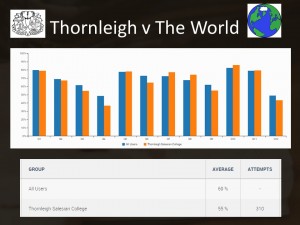Each week we set all our Year 11 Higher GCSE students a GCSE Essential Skills Quiz from my Diagnostic Questions website. These quizzes are completely free and are designed to test the content that appears on the majority of GCSE higher maths papers. These are the kind of questions that students should get right, but which time and time again cost our Year 11s the valuable marks that prevent them getting the grade they want.
We set our quizzes on a Monday, the students complete them for Friday, and then I sit down with a Mellow Birds coffee and a yoghurt (it is the weekend, after all) to analyse the results. I try to find one key insight, and then share it with staff in our weekly Departmental Meeting in a 5 minute slot called “Insight of the Week”.
Why not join in too by setting these quizzes to your Year 11s? The more the merrier!
Quiz 1 is below, followed by the key insight from this week.
How our students performed compared to the rest of the world:
The Insight of the Week comes from the question that caused our students the most problems, which was on simplifying algebraic expressions:
Only 37% of our students got this question correct, with C being the most common answer chosen, luring in 47% of them.
Let’s look at some of our students’ explanations to see if we can understand why:
Incorrect Answer A (10% of our students chose this)
This may be students mistaking the rules for multiplying with the rules for addition. Many student explanations for this choice of answer also highlight their compulsion to combine the powers of d together.
“2×3=6 DxD=D squared D squared add D = D cubed”
“Because d is 1 so if there’s 2 ds and one spare then 3ds”
Incorrect Answer B (6% of our students chose this)
Students opting for this answer believe you can add the numbers together and add the powers together, but interestingly also may have some notion of the need to keep numbers and letters separate
“3+2=5 (d squared)”
“d2 and d =d3”
Incorrect Answer C (47% of our students chose this)
By far the most popular choice. Students are determined to combine the terms in a way that seems the most sensible: add the numbers and add the powers.
“i think this because 2 and 3 is 5 and if you add the d’s on you get in a total of 3 d’s”
“3 plus 2 is 5 and d to the power of 2 plus another d is d to the power of 3”
“3 + 2 = 5 d squared + d = d cubed d cubed + 5 = 5d3 (d cubed)”
One of my motivations for developing Diagnostic Questions was so that students all around the world cold learn from each other. So, what are our Year 11 students’ favourite correct explanations to help them resolve their own misconceptions?
“because d squared and d are different things so you can’t put them together because it wouldn’t make sense”
“you cannot group these terms together – d and d squared are two completely different things.”
“because you can only collect like terms and these aren’t like terms”
Tackling the Misconception in Class
So, when we discussed this insight in our Departmental Meeting, what ideas did we come up with for resolving the misconceptions in lessons this coming week with our students:
- Substitute numbers in for d to show that the expressions are not equal
- Explicitly name the terms different things – “d” and “d squared”
- Write the expressions out in full, so 2d^2 would be 2 x d x d
- Write the expressions in the form d^2 + d^2 and d + d + d, and compare this to a + a and b + b + b
Please add any extra ideas in the Comments section below!
The series of GCSE Essential Skills Quizzes are available here and will always be completely free.
Quiz 2 is available here
I hope this quizzes will prove useful to help your students develop the essential skills necessary for success at GCSE, and aid your teachers gain a deeper understanding of how your students learn.



Hi, I’d really like to use the y11 quizzes but can’t remember my password!
Thanks,
Sarah
Hi Sarah,
Just click on re-set password, on the login screen.
Craig
How about some visual props – cubes to represent d cubed, squares to represent d squared, and lines to represent d. That way the students can see that they can’t just add a cube to a square.
Brilliant suggestion!
I think a key thing for students to initially understand is the difference between “simplify” / “rearrange” and “solve”. The tips and hints I give inlcude “look at the answer box” (e.g if there is a x = …or…” it is going to be a “solve”. The difficulty is often “how far do you go, how do you know when to stop?”…often the clue is in the question *e.g. if it involves circles and says “give an exact answer” it means leave Pi in. Or if it says express answer as a Surd it means put the Surd on top.
I think specifically on the 2d squared.. problem/or type of problem, the difficulty is that when you “bring the common factor d to the front” you have to remember to put the (implied) bracket round the original and divide it by d.